FOR IMMEDIATE RELEASE – PRESS RELEASE
CMC condemns Thai use of cluster munitions in Cambodia
Thailand and Cambodia should join global treaty banning cluster munitions
(Bangkok/ Geneva, 6 April 2011) – Based on two separate on-site investigations, the Cluster Munition Coalition (CMC) has concluded that Thailand used cluster munitions on Cambodian territory during the February 2011 border conflict. Thai officials confirmed the use of cluster munitions in a meeting with the CMC on 5 April.
This is the first use of cluster munitions anywhere in the world since the 2008 Convention on Cluster Munitions entered into force and became binding international law. The CMC condemns any use of cluster munitions, and urges Thailand and Cambodia to immediately commit to no future use and to accede to the global treaty banning the weapons.
“It’s appalling that any country would resort to using cluster munitions after the international community banned them,” said Laura Cheeseman, director of the CMC. “Thailand has been a leader in the global ban on antipersonnel mines, and it is unconscionable that it used banned weapons that indiscriminately kill and injure civilians in a similar manner.”
In a meeting on 5 April, the Thai Ambassador to the UN in Geneva confirmed Thai use of 155mm Dual Purpose Improved Conventional Munition (DPICM) cluster munitions. The Ambassador said Thailand used cluster munitions “in self-defence”, using the principles of “necessity, proportionality and in compliance with the military code of conduct”. He alleged heavy use of rocket fire by Cambodian forces against civilian targets in Satisuk, in the Khun Khan district of Thailand.
In February and April of this year, CMC members conducted two separate missions to cluster munition contaminated areas in Cambodia including in Svay Chrum Village, Sen Chey Village and around the Preah Vihear temple hill, and witnessed unexploded submunitions and fragmentation damage caused by cluster munitions. Norwegian People’s Aid confirmed that unexploded M42/M46 and M85 type DPICM submunitions have been found.
Atle Karlsen of Norwegian People’s Aid said, “There are around 5,000 people living in Sen Chey village that are at risk from these unexploded weapons. Thailand must supply information to help clear affected areas and make them safe for civilians to return home.”
Sister Denise Coghlan, a CMC leader who took part in the first research mission said, “These cluster munitions have already robbed two men of their lives, two more have lost their arms and a further five were injured. The area must be cleared immediately to prevent more suffering. Cambodia must make every effort to ensure the safety of civilians.”
The CMC has urged Thailand to provide detailed information on the results of its inquiry, including the location of all cluster munition strikes, so that civilians can be adequately warned of the dangers and to assist the effective and efficient clearance of submunition remnants, which pose dangers like landmines. The CMC is also calling on Cambodia to accede to the Convention on Cluster Munitions and as interim steps commit to no use, make known the types and quantity of cluster munitions in its stockpile and start destruction.
Cambodia and Thailand are not among the 108 countries that have signed the Convention on Cluster Munitions but each has joined the 1997 Mine Ban Treaty. Both countries participated in the “Oslo Process” to negotiate the Convention on Cluster Munitions and attended its First Meeting of States Parties in neighbouring Lao PDR in November 2010.
“This conflict should spur both countries to take urgent action to denounce the weapons and join the ban treaty,” said Cheeseman.
The Convention on Cluster Munitions entered into force as binding international law on 1 August 2010, banning the use, production, stockpiling and transfer of cluster munitions, while requiring states to destroy stockpiles, clear contaminated land and assist victims and affected communities. Of the 108 countries that have signed the Convention since it opened for signature in December 2008, 55 countries have already ratified.
Contacts:
Sister Denise Coghlan
Cambodian Campaign to Ban Landmines and Cluster Munitions, Cambodia, +855-124-88950
Laura Cheeseman
Cluster Munition Coalition, UK, +44-7515-575-175
Photos of contamination in Cambodia
© Stéphane de Greef, Landmine and Cluster Munition Monitor
http://www.flickr.com/photos/clustermunitioncoalition/sets/72157626310392061/with/5592080603/
+++
Detailed background
From 4-7 February 2011, Thai and Cambodian troops exchanged fire over disputed territory along the border near Preah Vihear temple, a UNESCO World Heritage site. On 10 February, the state-sponsored Cambodia Mine Action Centre (CMAC) reported (http://www.cmac.gov.kh/tblnews.php?id=68) it had evidence that Thai forces had fired cluster munitions into parts of Preah Vihear province.
CMC members undertook a research mission to the Cambodian side of the border on 12 February, where they witnessed and photographed submunitions that had failed to explode in two areas – the military and police base in Svay Chrum village and the Preah Vihear temple hill. In Svay Chrum, CMC members photographed unexploded cluster submunitions lying out in the open and numerous cluster munition remnants, as well as structures and a vehicle with physical damage consistent with that caused by cluster submunition explosions.
A cluster submunition allegedly exploded when a Cambodian policeman picked it up after the initial strike at the base, killing two policemen and injuring seven others. The research team interviewed two of the victims at Preah Vihear referral hospital in Tbeng Meanchey, who sustained fragmentation wounds to the arms, torso and head as well as interviewing two other victims in Siem Reap Provincial hospital who had each lost an arm in the explosion. When asked if they could identify the device that caused their injuries, each independently pointed to a picture of an M46 cluster submunition.
On a separate assessment mission carried out from 1-2 April 2011 by CMC member Norwegian People’s Aid (NPA), 5 cluster munition contaminated areas were visited: Sen Chey village, Preah Vihear temple hill, a new village development area in Northwest Sraaem, an open agricultural field behind a military camp, and a police camp in Svay Chrum village. NPA identified M42/M46 and/or M85 type submunitions in all of these areas. An additional 7 areas have been identified by the Cambodia Mine Action Centre (CMAC) as being contaminated by cluster munitions as a result of strikes but it has not been possible for NPA to access these areas. The 12 cluster munition strike areas are within a 300km2 area according to CMAC.
CMC members photographed unexploded submunitions in the contaminated areas. http://www.flickr.com/photos/clustermunitioncoalition/sets/72157626310392061/with/5592080603/
CMC analysis of the photographs indicates that the submunitions are M46-types, contained in NR-269 155mm artillery projectiles. Each projectile contains 56 submunitions, which are a copy of the United States M46 submunition. Upon subsequent inquiries by CMC members, Thailand acknowledged possessing the NR-269 projectiles with M46-type submunitions. Unexploded M85 type submunitions with a self-destruct mechanism have also been found in an agricultural field next to the military camp.
Both countries possess stockpiles of cluster munitions, but little is known about their status or composition. The Cambodian government has in the past cited an ongoing review of its defence and security situation as the reason for a delay in joining the treaty. Thailand has cited concerns over its ability to destroy its stockpile as a roadblock to joining the Convention, as well as security concerns. Thailand announced in 2008 that it had no intention of using the weapons in the future.
Cambodia and Thailand are States Parties to the 1997 Mine Ban Treaty and Cambodia will host that treaty’s 11th Meeting of States Parties in November 2011.
South-East Asia is more heavily contaminated by cluster munitions than any other region after the United States dropped large numbers of cluster bombs on Cambodia, Lao PDR and Vietnam in the 1960s and 1970s.
For more information on cluster munition policy and practice, please see the following Cluster Munition Monitor 2010 country reports:
• Cambodia
• Thailand
http://www.the-monitor.org/
Cluster Bombs in Casing
Project Pineapple
Remember, go to Archives for full story at bottom of picture column
SPECIAL UPDATE FOR AMERICANS
FOR NON AMERICANS PLEASE PASS ON TO YOUR US FRIENDS AND CONTACTS
PLEASE VIEW SITE
http://www.handicap-international.us/our-fight-against-landmines-and-cluster-bombs/in-brief/
AND FIND LINK TO
National Senate Call-In Day to Ban Cluster Bombs MAR 30
but keep up the pressure after this date
MAKE SURE YOU CONTACT YOUR SENATOR
ALSO for those who wish to make donations to Handicap International, a co-founder of the International Campaign to Ban Landmines (ICBL) which was awarded the Nobel Peace Prize in 1997, and now widely recognized as a key international lobbyist on weapons of war, please got to:
http://apps.facebook.com/causes/285080?m=96aaaf39
Be sure to contact your political representative too wherever you are.
PROJECT PINEAPPLE INITIATED WITH A MOTORCYCLE RIDE THROUGH INDOCHINA TO PUBLICISE THE CLUSTER BOMB ISSUE.
Laos was carpet bombed along the Vietnam border to wipe out the VietCong's supply lines, the multiple trails known as the Ho Chi Minh Trail. Now, the issue is still being swept under a diplomatic carpet.
The Iraq war opened on 19th March, 2003, with Cluster Bombs being dropped. I was in Laos walking through remote villages on a water well project when I got the news on my short wave radio. Those same villages were carpet bombed 35 years earlier and still living under the threat of 76 million unexploded Cluster Bombs.
Billions of dollars continue to be spent on Iraq but a mere 500 thousand dollars annually on clearing unexploded Cluster Bombs in Laos.
The Vietnam War ended on 30th April 1975 when the last ten marines were choppered out.
I used the Belarusian 125cc Minsk motorcyle to ride from Hanoi, Vietnam, through Laos and Cambodia to Ho Chi Minh City between 19th March and 30th April representing respectively the start of Cluster Bombs being dropped on Iraq and the final withdrawal of US marines from Saigon.
Visits were made to various relevant projects and programs both for clearing unexploded bombs and supporting the victims.
Should you be in any of these countries it is worth
finding out what you can about this 'forgotten' problem. Rural children and adults are still dying and being maimed every day.
Please email any comments to : project.pineapple@yahoo.com
Remember to go to Blog Archives at bottom of Picture column for the full story.
See you around
Robert
SPECIAL UPDATE FOR AMERICANS
FOR NON AMERICANS PLEASE PASS ON TO YOUR US FRIENDS AND CONTACTS
PLEASE VIEW SITE
http://www.handicap-international.us/our-fight-against-landmines-and-cluster-bombs/in-brief/
AND FIND LINK TO
National Senate Call-In Day to Ban Cluster Bombs MAR 30
but keep up the pressure after this date
MAKE SURE YOU CONTACT YOUR SENATOR
ALSO for those who wish to make donations to Handicap International, a co-founder of the International Campaign to Ban Landmines (ICBL) which was awarded the Nobel Peace Prize in 1997, and now widely recognized as a key international lobbyist on weapons of war, please got to:
http://apps.facebook.com/causes/285080?m=96aaaf39
Be sure to contact your political representative too wherever you are.
PROJECT PINEAPPLE INITIATED WITH A MOTORCYCLE RIDE THROUGH INDOCHINA TO PUBLICISE THE CLUSTER BOMB ISSUE.
Laos was carpet bombed along the Vietnam border to wipe out the VietCong's supply lines, the multiple trails known as the Ho Chi Minh Trail. Now, the issue is still being swept under a diplomatic carpet.
The Iraq war opened on 19th March, 2003, with Cluster Bombs being dropped. I was in Laos walking through remote villages on a water well project when I got the news on my short wave radio. Those same villages were carpet bombed 35 years earlier and still living under the threat of 76 million unexploded Cluster Bombs.
Billions of dollars continue to be spent on Iraq but a mere 500 thousand dollars annually on clearing unexploded Cluster Bombs in Laos.
The Vietnam War ended on 30th April 1975 when the last ten marines were choppered out.
I used the Belarusian 125cc Minsk motorcyle to ride from Hanoi, Vietnam, through Laos and Cambodia to Ho Chi Minh City between 19th March and 30th April representing respectively the start of Cluster Bombs being dropped on Iraq and the final withdrawal of US marines from Saigon.
Visits were made to various relevant projects and programs both for clearing unexploded bombs and supporting the victims.
Should you be in any of these countries it is worth
finding out what you can about this 'forgotten' problem. Rural children and adults are still dying and being maimed every day.
Please email any comments to : project.pineapple@yahoo.com
Remember to go to Blog Archives at bottom of Picture column for the full story.
See you around
Robert
One Reason for the Name Project Pineapple

America versus China
Monday, May 2, 2011
Subscribe to:
Post Comments (Atom)
Another Good Reason for Name Project Pineapple

This cluster bomb, known as a pineapple, which is still active, is in the collection of Tourist Information at Phonsavan, Plain of Jars, Laos
Two Good Reasons for Image on Project Pineapple Logo

Cope publicity staff Soksai 'plays' Project Pineapple logo
Mr Ta, No Arms One Eye, Cluster Bomb Victim

This is what the ride is about, to stop the perpetrators of these weapons
An Animated Mr Ta Gesticulates....

....as best he can during interview with COPE's Cluster Bomb display behind
'Handling' His Misfortune by Selling Maps at War Museum, Sai Gon

This victim armless, one legged, one eye, is pragmantic, I shook his 'hand' with both of mine
Arms and Legs All Over The Place

That's COPEs limb fitting centre, not going out of business soon, unfortunately.
Colourful Collection of Cluster Bombs

A tasty collection, you can see why kids enjoy playing with them
Togehter We Can Make It Happen

Bomb Awareness Day in Vientiane, is that an American flag I see before mine eyes?
Out of Nong Across to Along and The Hardest Trail

The Along villagers build this crossing during the dry season with a hefty toll on the otherside
War Vet Wonders Where The Good Times Went, And His Leg

The restrained display opposite the City Opera House on Le Loi Avenue, Sai Gon
International Artist Supports Project Pineapple
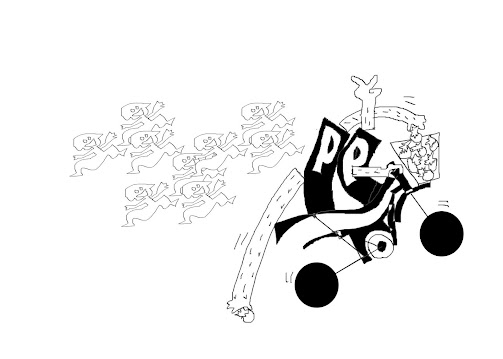
Man Winkler's contribution to the project , see blog entry, April 22
Little Remains After 40 Years of Scrap Hunters

Too big with rusted bolts for the recycling confirms you are on the Trail
Forest Fire

Sunset on Lao at the Viet Nam border. Imagine these skies on real fire 40 years ago.
Descendant of First Generation Clearance Team

Pigs, Dogs and Children were the first to clear UXOs before western conscience finally activated, see website
Jettisoned Fuel Tank Takes to the Air Again

B52s dropped their supplimentary fuel tanks after their deadly Cluster Bomb missions
UXO Lao Xekong meet Project Pineapple

Mr Tawee and some of his crew receiving COPE's brouchures
Mountain Villagers Have Little But The Land They Live On

Why should these people be suffering from the war remants so flagrantly scattered 40 years ago?
Complex Weaving Designs Take a Complex Comprehension

Villagers skilled in weaving intricate designs easily capable of searching their mountainous forest floor plan
Unstoppable Road Development of the Ho Chi Minh Trail

Parking a Minsk even for a moment can be hazardous
Minsk 125cc 2002
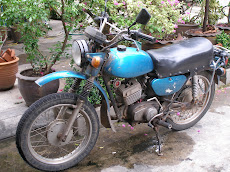
Your going on that? remarked Tony, the web man.
What's that Minsk doing up there?

It's on the way to my 'local' mechanic in Luang Prabang of course.
My 'Local' Mechanic
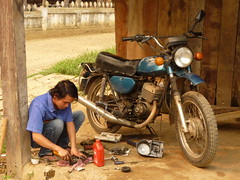
Hey Joe, Second Gear, not Top Gear
A Jarring Ride
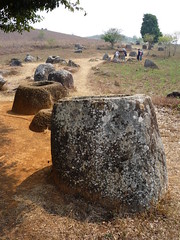
Phonsavan, Pathet Lao stronghold
Hanoi, Minsk's Second Fix

Snagging repairs after first fix
The Ride Kickstarts

Project Pineapple departs from Bach Mai Hospital, Hanoi
The Big House Pitstop

Not reaching the start of the Ho Chi Minh Trail on the first day we make a pitstop at this fine traditional Big House.
Cam Thuy, Start of the Ho Chi Minh Trail

Outside the restaurant, our last meal together before they head north and I south
Project Pineapple Riders

Ben from Australia, with 32 biking trophies to his name, rides the Minsk in Hanoi
Ho Chi Minh's Birth Place

Not far off the Trail to which he gave it's name, Uncle Ho's house
Phong Nga Cave's now Toothless Mouth

Like Venice, Cave Gondaleers have time
Spooked at Trail Crossroads

Tien with Jokers Alain and Ludivec
Moody Mountains of Mordor

The Spooky crossroads of the Trail
Friendly French

Missing a gear change causes a photo op returning to the caves
Chain of Events cause Delays

Tuan speedily replaces clutch and drive chain




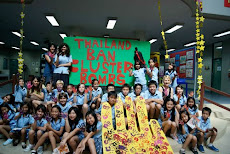


































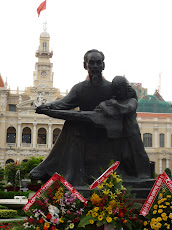















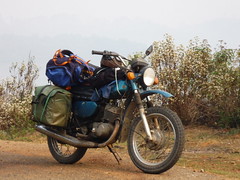







No comments:
Post a Comment